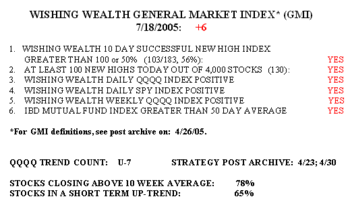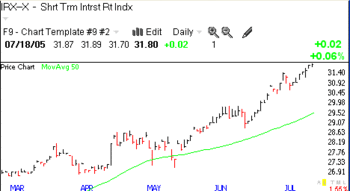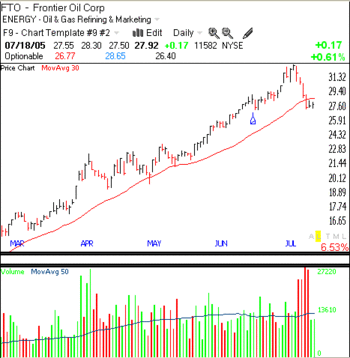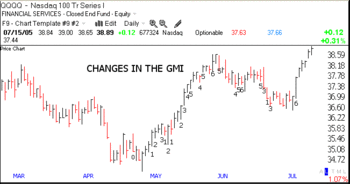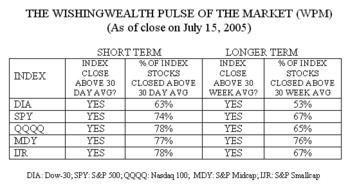Another strong day. There were 522 new highs and only 15 new lows. 61% of the Nasdaq 100 stocks, 76% of the S&P 500 and 83% of the Dow 30 stocks advanced today. Yes, even the Dow stocks are finally moving up. The GMI remains at +6 and has been so since this uptrend began on July 8. 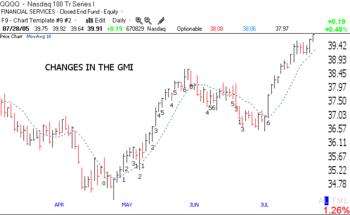 The chart (click on it to enlarge) shows the changes that have occurred in the GMI since I began posting it in April. Note that the GMI registered a maximum +6 on July 8 when the QQQQ closed at 37.77. In this rise as in the prior May rally the QQQQ consistently closed above its rising 10 day moving average (the dotted line). Since July 8 the QQQQ has closed above its 10 day every day. Hint: When is the market weakening? Wait for a close below the dotted line. To make $$$ in this rise one merely could have bought the QQQQ on July 8 or 9 and held on. Aggressive traders could have bought call options on the QQQQ and made a killing. Why mess around with individual stocks when one can merely trade this index? Until the 10 day average tops out, I see no reason not to be long Nasdaq 100 type stocks. As I said weeks ago, if the train is moving in the direction I want to go, I don’t argue with it–hop on. I can always jump off when it changes direction. I ignore the economy and the machinations of the pundits and economists—I just follow the dotted line……………………..
The chart (click on it to enlarge) shows the changes that have occurred in the GMI since I began posting it in April. Note that the GMI registered a maximum +6 on July 8 when the QQQQ closed at 37.77. In this rise as in the prior May rally the QQQQ consistently closed above its rising 10 day moving average (the dotted line). Since July 8 the QQQQ has closed above its 10 day every day. Hint: When is the market weakening? Wait for a close below the dotted line. To make $$$ in this rise one merely could have bought the QQQQ on July 8 or 9 and held on. Aggressive traders could have bought call options on the QQQQ and made a killing. Why mess around with individual stocks when one can merely trade this index? Until the 10 day average tops out, I see no reason not to be long Nasdaq 100 type stocks. As I said weeks ago, if the train is moving in the direction I want to go, I don’t argue with it–hop on. I can always jump off when it changes direction. I ignore the economy and the machinations of the pundits and economists—I just follow the dotted line……………………..
Speaking of dotted lines. I am now going to show you a most unorthodox "Naked Chart.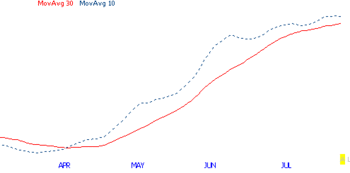 " This
" This
chart contains 2 moving averages without the daily prices. The dotted line is the 10 day average and the red line is the 30 day average. Now it does not take a rocket scientist to see that one could have made a handsome profit by buying when the dotted blue line crossed above the red line. One might even say that the prices obscure the trend. The trend is sure apparent here, isn’t it? Fortunately, TC2005 allows me to make any indicator invisible while letting the data be used in the chart. Do you think you might have been able to hang on to this stock and not be shaken out? Can you guess what stock this is? Take a look below. It’s our friend, GOOG! Note how the chart with the prices visible actually obscures the pattern of the moving averages. 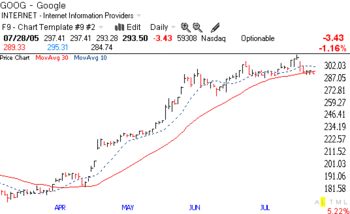 Maybe we could all trade more calmly if we just focused on the two moving averages in Naked Charts. Even if we can’t avoid looking at the prices, one rule that could be taken from this exercise is to only go long stocks when their 10 day average is above their rising 30 day average. In case you think this technique only works well for GOOG, take a look at this past winner. TASR topped out in early 2005 around 33 after doubling in about 4 months. Here is what the daily 2 average Naked Chart looks like.
Maybe we could all trade more calmly if we just focused on the two moving averages in Naked Charts. Even if we can’t avoid looking at the prices, one rule that could be taken from this exercise is to only go long stocks when their 10 day average is above their rising 30 day average. In case you think this technique only works well for GOOG, take a look at this past winner. TASR topped out in early 2005 around 33 after doubling in about 4 months. Here is what the daily 2 average Naked Chart looks like. 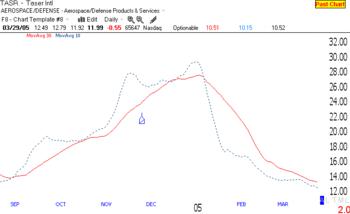 Can you see the sell signal at the top?…………………………..
Can you see the sell signal at the top?…………………………..
I told you before that the great Nicolas Darvas (see his books listed at right) looked for stocks hitting new highs that have doubled in the past year. Here is a list of stocks that hit new highs today, doubled in the past year and had triple digit increases in earnings in the most recent quarter listed by TC2005: NPSN,ATPG,CNXS,ISRG,TZIX,PLCC,TS,NTRI,HP,SWB,FORD,ATRO,USAK,LAN,
POT,JLG,LIFC,HOLX,BTJ,BTU. This would be an excellent watchlist to research to find the next big market winner–as long as the GMI holds up.
I introduced some new ideas tonight. I would greatly appreciate your comments. Please send me your feedback at: silentknight@wishingwealthblog.com.
